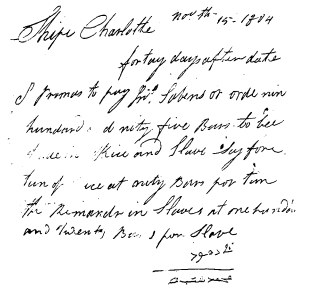Article contents
An 1804 Slaving Contract Signed in Arabic Script From the Upper Guinea Coast
Published online by Cambridge University Press: 13 May 2014
Extract
Few slaving agreements contracted between African sellers and American purchasers appear to have survived. They were rarely committed to paper, were destroyed after commitments were fulfilled, or were removed from business records kept by slave traders. The contract discussed here is of considerable interest as a document which, although brief, records important information and offers intriguing insights concerning African-European and African-African relationships in Guinea-Conakry at the turn of the nineteenth century.
The slaving contract is dated 15 November 1804, and apparently was negotiated aboard the merchant ship Charlotte of Bristol, Rhode Island, Jonathan Sabens, master, anchored at the Iles de Los archipelago.

Nov. th[ursday] 15-1804
Shipe Charlotte
fortay days after date I Promas to pay Jno. Sabens or orde[r] nin[e] hundard and ni[ne]ty five Bars to be Pade in Rice and Slave Say fore tun of Rice at nity Bars par tun the Remandr in Slaves at one hundard and Twenty Bars par Slave.
- [signed in Arabic] Fadmod [Fendan Modu Dumbuya]
- [signed in Arabic] Muhammad Sa'ab shokr Mohammed Sakib Fana/Ta/ Mohammed Shabaan
- (the month before Ramadan)
Respecting the American traders involved, the Charlotte was jointly owned by George D'Wolf and Jonathan Sabens of Bristol, Rhode Island. Captain Jonathan Sabens was an experienced mariner, involved in at least three previous slaving voyages, including one as master of the Charlotte. Members of the D'Wolf family were associated with numerous slaving voyages to west Africa and continued to invest in slaving ventures long after Rhode Island made the trade illegal in 1787.
- Type
- Research Article
- Information
- Copyright
- Copyright © African Studies Association 1987
References
Notes
1. Documents concerning the Charlotte's voyage are deposited in the D'Wolf Papers at the Bristol Historical Society. We are indebted to Captain Charles O. Cook, Jr., Michael Levesque, Ruth Sanford, Helen Tessler, and Charlotte Young for their assistance. We are also indebted to Adbullah Munahi Al-Otaibi, Abdirahman Beileh, Adam Egeh, Kathryn L. Green, John Kabba Kamara, Martha B. Kendall, Bradford G. Martin, and Fouzia Sabil for transliterating and discussing the Arabic script.
2. For background on the D'Wolf family and Bristol, Howe, George, Mount Hope: A New England Chronicle (New York, 1959)Google Scholar; Hamm, Tommy T., “The American Slave Trade with Africa, 1620-1807” (Ph.D., Indiana University, 1975), Chapter 3Google Scholar; and Jay A., Coughtry, The Notorious Triangle (Philadelphia, 1981), 47–49.Google Scholar
3. For American trade with West Africa during this period, Brooks, George, Yankee Traders, Old Coasters, and African Middlemen (Boston, 1970), Chapter 2.Google Scholar
4. Golberry, S.M.X., Travels in Africa (London, 1803), 2: 168–70, 193Google Scholar; Boyle, James, A Practical Medico-Historical Account of the Western Coast of Africa (London, 1831), 14–17Google Scholar; Britain, Great, Admiralty, The African Pilot (London, 1856), 86–87.Google Scholar
5. For trade during this period, Mouser, Bruce, “Trade, Coasters, and Conflict in the Rio Pongo from 1790 to 1808,” JAH, 14 (1973), 45–64CrossRefGoogle Scholar; idem., “Landlords-Strangers: A Process of Accomodation and Assimilation,” IJAHS, 8 (1975), 425–40; and Brooks, , Yankee Traders, 58–65Google Scholar; 169-73. For expansion of Fula hegemony coastward into the Nunez and Pongo areas see McGowan, Winston, “The Development of European Relations with Futa Jallon and the Foundation of French Colonial Rule, 1794-1897,” (Ph.D., University of London, 1978), 38–44, 65–74, 103–06Google Scholar: and Barry, Boubacar. “The ExDansion of the Futa Jallon towards the Coast and the Social and Political Crises in Southern Senegambia during the First Half of the Nineteenth Century” (unpublished paper, 1983)Google Scholar, passim.
6. For Thomas William, Great Britain, Privy Council, letter from John Matthews…, 16 April 1788; National Maritime Museum, Greenwich, Log/M/21, “Sandown.”
7. See Skinner, David, “Mande Settlement and the Development of Islamic Institutions in Sierra Leone,” JAHS, 11(1978), 45–46Google Scholar; idem., Thomas George Lawson: African Historian and Administrator in Sierra Leone (Stanford, 1980), 57-58; and Smith, Alexander, “Journal of a Voyage from Sierra Leone to the River Kisi Kisi…February 1805…,” Sierra Leone Collection, University of Illinois-Chicago LibraryGoogle Scholar, passim.
8. “Richard Bright Journal,” entry dd 18 October 1802, in Mouser, , ed., Guinea Journals: Journeys into Guinea-Conakry during the Sierra Leone Phase, 1800-1821. (Washington, 1970), ms. 89. pp. 79–80.Google Scholar Dumbuya asserted that the lands neighboring one of his villages produced 360 bales of cotton annually, plus a considerable quantity of wild and cultivated coffee. For Dumbuya's interests in Freetown, see Watt, James, “Journal of Mr. James Watt, in his Expedition to and from Teembo in the Year 1794,” Rhodes House Library, Oxford, Mss. Africa S.22, 121.Google Scholar
9. One such example concerns the Sloop Dolphin of Warren, Rhode Island, Captain Eddy. Captain Eddy arrived in west Africa in October 1795 and soon found himself enmeshed in a web of advancing trade goods while experiencing unending delays awaiting deliveries of promised African commodities. Eddy remained at the lies de Los for nearly eleven months, waiting for cargo that never arrived. Meantime, the Dolphin deteriorated rapidly and was juried unfit to sail. Eddy lost not only his cargo but also his vessel. Mouser, , “The Voyage of the good Sloop Dolphin to Africa, 1795-1796,” American Neptune, 38(1978), 249–61.Google Scholar
10. For discussion of iron bars and bar prices see Curtin, Philip D., Eoonomio Change in Preoolonial Africa; Senegambia in the Era of the Slave Trade (Madison, 1975), 240ff.Google Scholar
11. Coughtry, , Notorious Triangle, 277.Google Scholar
12. Ibid., 279, 285.
- 2
- Cited by


